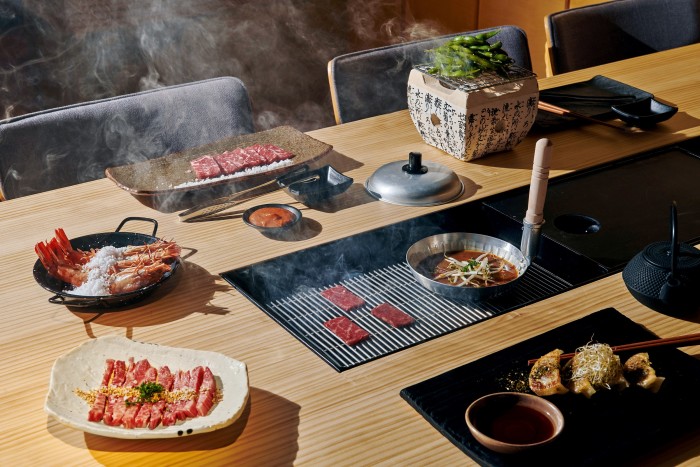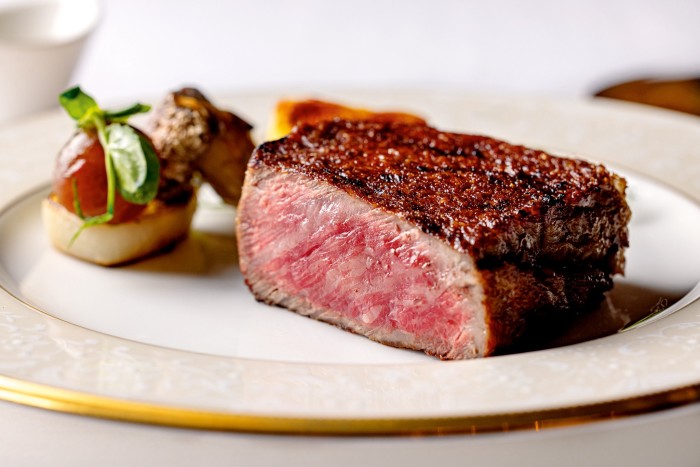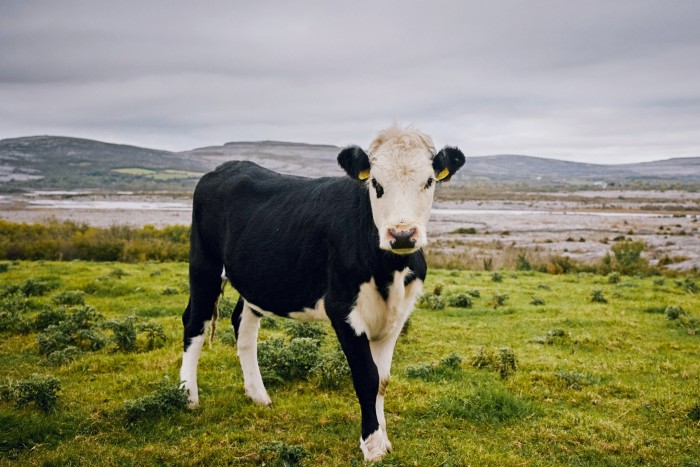Unlock the Editor’s Digest for free
Roula Khalaf, Editor of the FT, selects her favourite stories in this weekly newsletter.
When it comes to steak, there can be few experiences more rarefied than the Sansekai menu at Japanese restaurant Marie Akaneya in Paris. The restaurant specialises in sumibiyaki or charcoal grill. The Sansekai menu is available at one table each night and starts with a pouring of freshly ionised water (whose pH and time of ionisation are marked on a tag). A dozen courses follow, including beef broth, beef gyoza and Kobe beef, before the star – Matsusaka beef tenderloin from Ito Ranch in Japan.
Matsusaka is the most revered of all Wagyu (or Japanese) beef. Due partly to export restrictions, it’s only now starting to appear in restaurants outside Asia. Unlike other Wagyu appellations such as Kobe, which derive from cows and bulls, Matsusaka comes only from virgin females raised for 30 to 32 months (longer than any other stipulation in Japan). The fat in Matsusaka beef has an average melting point of 17°C (compared to 20°C in Kobe and 25°C in other Wagyu), resulting in the ultimate melt-in-the-mouth steak. Of 120 Matsusaka producers, Ito Ranch is the best, ageing its cows for 35 to 45 months and achieving a fat melting point of as little as 12°C. At Marie Akaneya, cuts include sirloin, chuck flap and rump. But tenderloin is the most coveted and exclusive to the Sansekai menu, which costs €520 per person.

The 60g serving to share consists of richly marbled, wafer-thin slices (three per person), which you grill at the table and season with Hoshi Shio sea salt, wasabi salt or a Japanese salt-and-pepper mix. Each strip dissolves on your tongue like a beef pastel. Or a square of bovine dark chocolate. A sensational taste experience worth the wait.
“People love steak because of the way it makes them feel,” writes Mark Schatzker in his book Steak. “It delivers flavour, tenderness and juiciness in a combination equalled by no meat.” Steak also appeals to people from all walks of life. But our sense of what makes the finest cut – not only in terms of flavour and texture but also how an animal is reared, finished and dry-aged – evolves. While at the premium end of the market, suppliers and restaurants jockey for the ability to say theirs is even more exclusive and expensive. But which is top? And is it just a matter of taste?

“Consistency is the most important thing,” argues Riccardo Giraudi, founder of Beefbar restaurants and CEO of European meat distributor the Giraudi Group. “It’s not about tenderness or taste. It’s that every time you have that steak, it’s the same.” When Giraudi began trading in premium beef 20 years ago, he recognised how inconsistent beef in Europe could be, thanks to a grading system that only prioritises percentage of fat and muscle. Grading systems elsewhere are more rigorous and wide-ranging – Japan’s rates marbling (from intramuscular fat) as a key component. When, in 2014, a European ban on Japanese imported beef after a BSE outbreak was lifted, Wagyu beef started to reappear on western menus. A decade later, Wagyu beef is synonymous with excellence, supplanting other favourites such as Argentinian or Irish meat.


The Wagyu-fication of steak continues. Flat Iron launched in 2011 with the aim of providing a quality steak experience at a reasonable price. Last month the British chain introduced its first own-bred British Wagyu (with F2 designation, meaning 75 per cent Wagyu genetics) at its Covent Garden branch. Prime cuts of sirloin, ribeye and fillet retail from £22, compared to £14 to £20 for non-Wagyu. “It’s the most expensive steaks we’ve done,” says Flat Iron’s head of beef Fred Smith. “But still good value. Wagyu is the only breed people understand paying more for.”
What’s your beef?

Huw Gott, co-founder of Hawksmoor
The key to great steak is happy cattle. All the hard work happens out in the fields. A great example is Farm Wilder, a not-for-profit social enterprise on a mission to bring back biodiversity. It supports farmers in following cutting-edge regenerative farming practices. The starting point is always grass. And grass needs rain, something the island of Ireland is blessed with. Some of my favourite steaks this year have been Irish – from Angus and Herefords free-roaming the wilds of the Burren in County Clare (burrenpremiumbeef.ie) to diminutive Dexters grazing a rewilding former golf course in County Dublin (donabatedexter.ie). An apt Irish farmers’ blessing: may the rains fall softly upon your fields.
Fred Smith, head of beef at Flat Iron
I love Parilla Don Julio in Buenos Aires, which has an array of Argentina’s best beef all cooked over charcoal. Also Julian de Tolosa, in Tolosa near San Sebastián, where the chefs cook enormous beef chops over coals in the dining room. The beef is all old cow beef with a remarkable depth of flavour. In New York, there’s Peter Luger, one of the most famous steakhouses in the city, if not the country. Go for the über-tender prime porterhouse with hashed potatoes and don’t miss the cheesecake with schlag to finish. flatironsteak.co.uk
Kotaro Ogawa, founder of Aragawa
For me, chateaubriand is the most superior cut. It’s the best part of the fillet with the most character, but the umami from the red meat, especially in Japanese Wagyu chateaubriand, makes it extra-special. It’s tender, but has bite, everybody wants beef to melt in your mouth, but I like that this cut gives you something to chew on. In Tokyo, I recommend going to Gorio, a restaurant in the Ginza district.
Riccardo Giraudi, founder of Beefbar and CEO of Giraudi Group
My recommendation for one of the world’s best butchers, without a doubt, is Victor Churchill in Sydney and Melbourne. It has been my inspiration for many projects.
Conversely, the new Japanese restaurant Aragawa in London’s Mayfair is offering 40-month-reared Tajima beef sirloin to share for £900. I get to taste its slightly more affordable 36-month-reared sirloin to share for £760. The steak master, who has been flown in from Tokyo, skewers the 1.2in-thick cut with rods made from piano strings and judges when the steak is done by listening to the pitch of sizzling and dripping. Each bite delivers fatty succulence and a mildly beefy taste.
And yet, despite the appeal of top-grade Wagyu steak, I crave something chewier, beefier and bloodier. A few days later, I find myself at Hawksmoor, where a British-raised, grass-fed fillet delivers the chew, char and tang I’m after. Before founders Will Beckett and Huw Gott opened the first Hawksmoor in 2006, they toured the world tasting beef. “The clear winner was Longhorn cattle from a farm in north Yorkshire,” says Gott. “Apart from the Japanese Wagyu, it was by far the most expensive. When we visited the farm, we realised why. Every stage of the process, from animal welfare to dry ageing, was done more slowly. It was beef the way most people think it is produced – by cows in fields eating grass for most of their lives.”
Before opening the first American Hawksmoor in New York in 2021, Beckett and Gott sampled a lot of US beef. Most American beef cattle are intensively corn-fed and treated with antibiotics and hormones. The US focus on marbling delivers tender, juicy steak. “But for me that’s at the expense of flavour,” says Gott. “The first mouthful is wow. But it doesn’t carry on delivering.” The network of US farms they ended up working with felt comparable in standards to farms they worked with in the UK. “Ethics is flavour,” Beckett explains. “Happy animals are important.”
Of course the way a steak is cooked and plated plays a big part in how it’s appreciated. At Hawksmoor, steak is charcoal-grilled (a rarity in American steakhouses) and served without sauce. “A steak on a white plate with everything else on the side,” says Beckett. At Turkish chain Nusr-Et, customers famously pay a premium to have owner Salt Bae bounce salt flakes off his forearm onto their meat.

Steak is also a matter of national preference and pride. “In France, people like stronger secondary cuts like bavette,” says Giraudi. “In the Middle East they only eat it well done.” Taste for steak can be subject to fashion too. Old dairy cow (especially from Portugal and Spain) is increasingly popular. So is meat from less familiar breeds. At The Newt in Somerset, rare-breed British White is being championed and turns up in less mainstream cuts such as the terrifically full-bodied Denver steak I had.
Giraudi has been expanding the offering at Beefbar to include options such as tartare, bao, smoked brisket and gyoza. “People want to eat less meat but better,” he says. “They also want a different way to experience meat than just steak.” This is undoubtedly true. And yet certain occasions will always call for steak.
Stay connected with us on social media platform for instant update click here to join our Twitter, & Facebook
We are now on Telegram. Click here to join our channel (@TechiUpdate) and stay updated with the latest Technology headlines.
For all the latest Food and Drinks News Click Here
